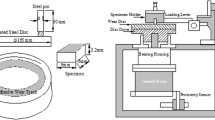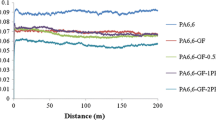Abstract
In general polymers are used in the form of composites (fiber reinforced, solid lubricated or both) in tribo-applications, where they may encounter more than one type of wear situations or mechanisms to different extents. The area of investigating the optimum concentration of fillers for best combination of tribo-performance in different wear modes and mechanical strength is sparingly researched. In this paper, research findings on the influence of the contents of short carbon fibers (CF) and PTFE (particulate form) in Polyamide (PA) 12 on friction and wear behavior in two wear modes (adhesive and fretting) have been reported. With increase in contents of CF up to 30% (vol) most of the mechanical properties and tribo-performance improved in adhesive and fretting wear modes. With a view to enhance it further, PTFE was added step by step in the best performing composite (PA+30% CF). This boosted the tribo-performance further, however, at the cost of strength properties. With increase in PTFE percentage (10, 15 and 20% by vol), specific wear rate (K o) and friction coefficient (μ) both decreased appreciably in adhesive as well as fretting wear modes. The composite consisting of 30% CF and 20% PTFE showed lowest values for μ and K o rendering it the best tribo-combination for all practical purposes. The abrasive wear behavior of composites was also investigated. However, wear performance in this mode showed exactly opposite trends. Inclusion of fibers or combination of fibers and PTFE proved detrimental.









Similar content being viewed by others
Notes
In the case of LAOW all selected parameters including amplitude are set before the experiment starts. Once the oscillation starts, generally amplitude falls below the set value and it is reset with the control panel. However, when load is very large and shearing forces are high, amplitude cannot be maintained even after applying maximum range provided in the control unit. This shows that the limiting load has reached. Sometimes amplitude reduces because of trapping of large particles of metal or polymer and falls to a low value for a short time. It regains once the particle either is thrown off or gets “wear thinned”. However, if the value falls below 80% of original value for a long time even after applying full possible force through control unit, it is realized that the material has reached the “failure limit” and cannot withstand the selected load. The experiment is abandoned and lower load is selected for next experiment.
References
Lancaster J.K., Friction and Wear in Jenkins A.D., (ed.), Polymer Science: A Material Science Handbook North Holland Amsterdam (1972) 959
Bijwe J., Mathur J.N., Tewari U.S., (1991) J. Synth. Lubr 8: 177
Friedrich K., Lu Z., Hager A.M., (1995), Wear 190: 139
J. John Rajesh, Investigations on abrasive and erosive wear behaviour of various polyamides and their composites, Ph.D. thesis (Indian Institute of Technology, Delhi, 2002)
Nylon Plastics Handbook, ed. by Melvin I. Kohan, Hansner/Gardener Publications Inc., Cincinnati, (1995)
Bijwe J., Indumathi J., John Rajesh J., Fahim M., (2001) Wear 249(8): 715
Steijn R.P., (1967), Met. Eng. Quart. Vol. 7: 9
Song J., Ehrenstein G.W., (1993) Friction and Wear of self-reinforced Thermoplastics, in Chap 2, Advances in Composite Tribology in Friedrich K., (ed.) Composites Materials Series 8 Elsevier New York
John Rajesh J., Bijwe J., (2004) Wear 256(1–2): 1
Stachowiak G.W., Batchelor A.W., (1993) Engineering Tribology, Tribology Series, 24 Elsevier Amsterdam, The Netherlands
Schulte K., Friedrich K., Jacobs O., (1993) Fretting and fretting-fatigue of advanced composite laminates, Chap 18, Advances in Composite Tribology in Friedrich K., (ed.), Composites Materials Series 8 Elsevier Amsterdam
PEEK Composites: Evaluation of tribo-performance in adhesive and fretting wear mode, Project report submitted to Gharda Chemicals, Mumbai (India) (2004)
Jacobs O., Friedrich K., Marom G., Schulte K., (1990), Wear 135: 207
Chievers T.C., Gordelier S.C., (1984), Wear 96: 153
Bill R.C., (1985), Wear 106: 283
Physical modification of PEEK for tribological applications, Project report submitted to DMSRDE, Kanpur (India) (2005)
John Rajesh J., Bijwe J., Tewari U.S., (2003), J. Synth. Lubr. 19(4): 327
Author information
Authors and Affiliations
Corresponding author
Rights and permissions
About this article
Cite this article
Bijwe, J., Naidu, V., Bhatnagar, N. et al. Optimum concentration of reinforcement and solid lubricant in polyamide 12 composites for best tribo-performance in two wear modes. Tribol Lett 21, 57–64 (2006). https://doi.org/10.1007/s11249-005-9010-7
Received:
Accepted:
Published:
Issue Date:
DOI: https://doi.org/10.1007/s11249-005-9010-7




